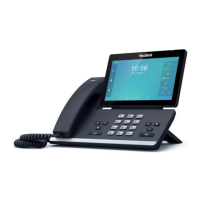Setting Up Your System
109
Boot Files, Configuration Files and Resource Files
When IP phones are configured with central provisioning method, they will request to download
the configuration files and resource files from the provisioning server.
The following sections describe the details of boot files, configuration files and resource files:
Boot Files
Configuration Files
Resource Files
Obtaining Configuration Files and Resource Files
Boot Files
You can use a boot file to customize the download sequence of configuration files. It is
efficiently for you to provision your IP phones in different deployment scenarios, especially
when you want to apply a set of features or settings to a group of phones.
Note
The boot files are valid BOOT files that can be created or edited using a text editor such as
UltraEdit. The boot files are first downloaded when you provision the phones using centralized
provisioning (refer to Central Provisioning). The configuration parameters are not included in
the boot file. You can reference some configuration files that contain parameters in the boot
files to be acquired by all your phones and specify the download sequence of these
configuration files.
Yealink supports two types of boot files: common boot file and MAC-Oriented boot file.
During auto provisioning, the IP phone first tries to download the MAC-Oriented boot file (refer
to MAC-Oriented Boot File), and then download configuration files referenced in the
MAC-Oriented boot file in sequence from the provisioning server. If no matched MAC-Oriented
boot file is found, the IP phone tries to download the common boot file (refer to Common Boot
File) and then downloads configuration files referenced in the common boot file in sequence. If
no common boot file is found, the IP phone downloads the common CFG file (refer to Common
CFG File) and MAC-Oriented CFG file (refer to MAC-Oriented CFG File) in sequence.
The following figure shows an example of common boot file:
#!version:1.0.0.1
#The header above must appear as-is in the first line
include:config <configure/sip.cfg>
include:config “http://10.2.5.206/configure/account.cfg”
You can select whether to use the boot file or not for auto provisioning according to your
deployment scenario. If you do not use the boot file, proceed to Configuration Files on page 111
.
That is, you can also use the old mechanism for auto provisioning.

